Trending
Opinion: How will Project 2025 impact game developers?
The Heritage Foundation's manifesto for the possible next administration could do great harm to many, including large portions of the game development community.

Deconstructeam speaks about the reasons why they made players craft their own tarot cards, and how that very player creativity creates tighter connections to their story and world.
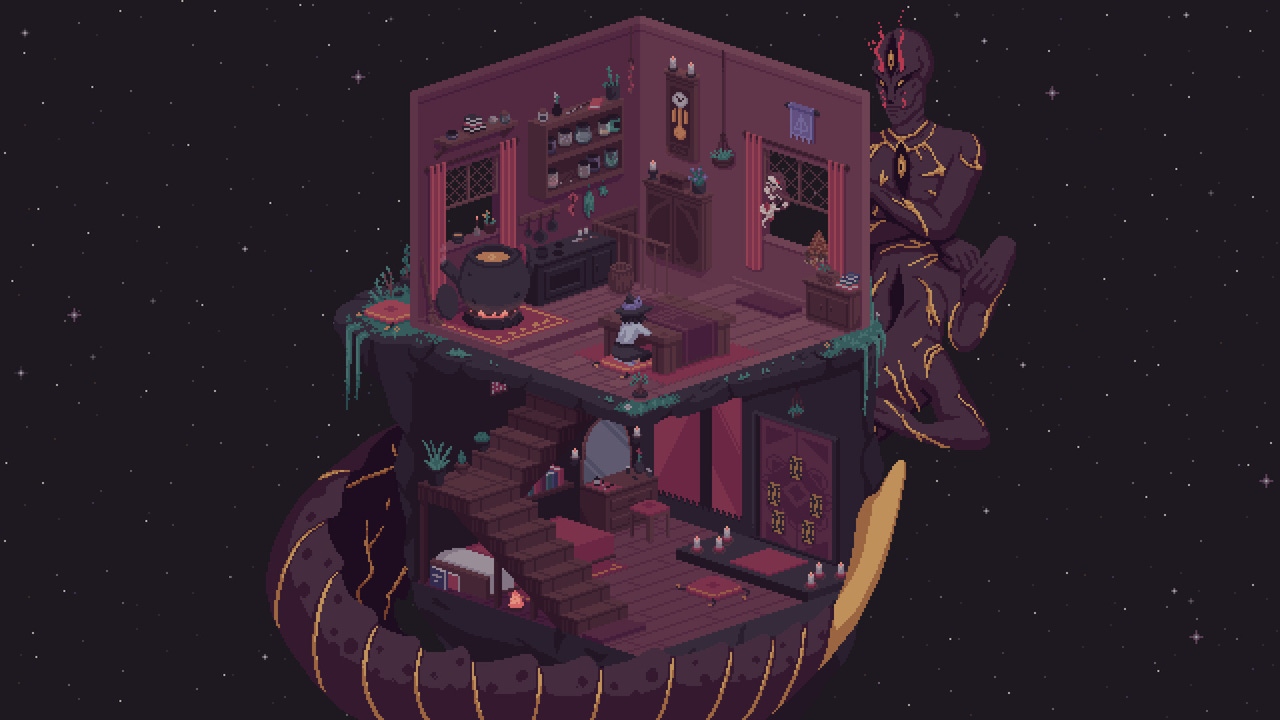
The IGF (Independent Games Festival) aims to encourage innovation in game development and to recognize independent game developers advancing the medium. Every year, Game Developer sits down with the finalists for the IGF ahead of GDC to explore the themes, design decisions, and tools behind each entry. Game Developer and GDC are sibling organizations under Informa Tech.
The Cosmic Wheel Sisterhood sees players crafting tarot cards and telling fortunes on an asteroid in space, watching how your predictions can reshape lives.
Game Developer spoke with Deconstructeam, creators of this Excellence in Narrative-nominated title, to talk about how encouraging player creativity can help them better connect with a game, the design ideas that went into the asteroid home where players would spend a great deal of time, and how they involved actual divination in crafting the story’s various branching directions.
Who are you, and what was your role in developing The Cosmic Wheel Sisterhood?
We are Jordi de Paco, Marina González and Paula Ruiz (aka fingerspit).
Jordi de Paco: I'm the director, designer, writer, and programmer.
Marina González: I'm the art director, pixel artist, animator, and producer.
Paula Ruiz: I handle all the audio and composed the soundtrack.
de Paco: In a team this small, though, the creative direction of the game is something subject to constant dialogue, and we inspire and affect each others' areas constantly.
What's your background in making games?
de Paco: I started making games on my own around 2012, but a couple of game jams later, Marina joined to improve the games with her art, and a year later Paula would join us to create all the music and sounds. We've been working together as Deconstructeam for more than 10 years now, and we've released 3 commercial projects: Gods Will Be Watching, The Red Strings Club, and The Cosmic Wheel Sisterhood, all of them published by Devolver Digital, along with almost 40 free short games.
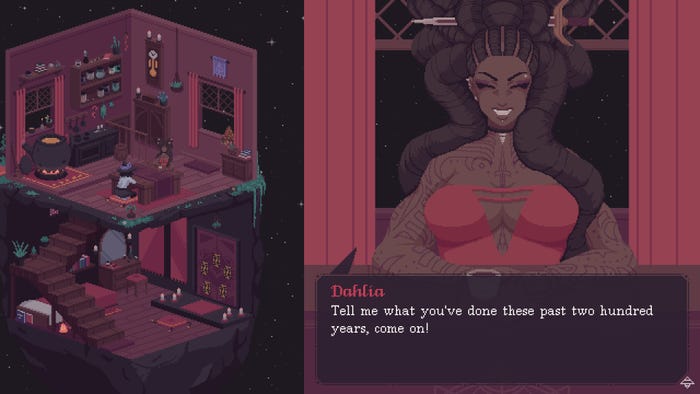
Images via Devolver Digital
How did you come up with the concept for The Cosmic Wheel Sisterhood?
González: It started as a pitch for a mobile platform that shall remain unnamed. It was originally centered around teacraft and not so much around Tarot. The thing is that our pitch was rejected, but Devolver saw potential in it and encouraged us to develop it for PC and consoles. In the process of redesigning it for the new platforms, for some reason we ended up betting more on the card-making divination.
de Paco: Well, actually, before starting development we were pretty skeptical regarding "magic," "divination," "Tarot," etc. Felt like total nonsense. But many of our friends, people who we love and respect, were super into it, and we couldn't understand why. It was through the art of challenging it, and trying to understand what was behind all this, that we ended up falling in love with it. We understood that magic is not some superstitious mystical nonsense, but a way of connecting with your instincts, your subconscious, and reaching to ideas you'd never be able to connect with through rational thinking.
Ruiz: There's also the aspect of adding player creativity to the mix. In 2018, we had developed a short game called Eternal Home Floristry about a hitman that hides at the back store of a flower shop while his injuries heal, and he had to work doing flower arrangement. The flowers you combined changed the meanings of the bouquet, much as the cards in The Cosmic Wheel Sisterhood, and we immediately fell in love with how inserting the player's creativity in the game mechanics increased the connection and immersion with the game's world.
What development tools were used to build your game?
de Paco: The game is developed using Game Maker. All the narrative stuff is all handled in Google Drive using Docs and Spreadsheets.
González: I do all the pixel art and animation with Adobe Photoshop.
Ruiz: I've been using FL Studio for years to make my music.
The Cosmic Wheel Sisterhood explores a story through fortunetelling and the dangerous choices we make sometimes. What appealed to you about connecting these ideas?
de Paco: Community. When we were studying divination we saw how it was a really powerful medium to connect with the people around you and talk about some intimate stuff that doesn't always come up naturally in conversation: fears, desires, hopes... Then there's also a lot of personal responsibility in what you advise and how you handle people's trust. You need to be sensitive and take good care of people who confide in you. But there's also a lot of room for corruption and manipulation if you were tempted to pursue your personal gain (of course, we didn't do that in real life [laughs]). We tried to channel all that energy and feelings into the game's narrative and characters.
How did the theme of fortunetelling affect the design of the game? How did you shape the game and experience around this concept?
de Paco: We took a deep dive into fortune-telling before developing the design and contents of the game. What we took from it is that divination is mysterious—you gain understanding by exposition and you train your instincts in relation to this art. When we created the narrative and card-making system, we aimed to translate this sensation. We didn't want to have a crystal-clear system in which you could see that doing A takes you to B. That's why we created a grimoire with esoteric texts, and upon combining the arcana you have a vague idea of what every card could mean. However, it's not until you use your deck many times that you start getting a grasp of it, but never master it completely, like a real Tarot deck. The system is obscure by design.
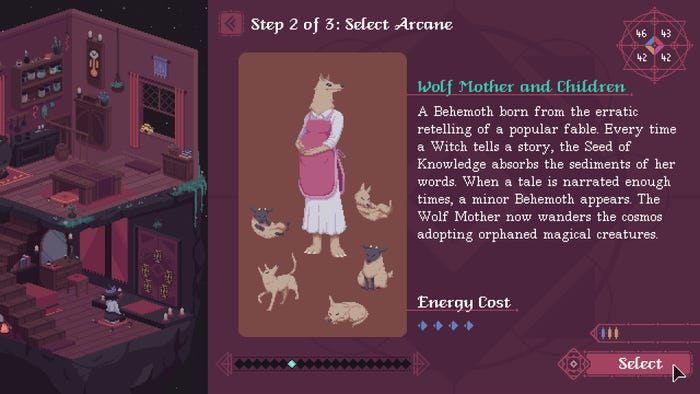
Images via Devolver Digital
Can you tell us a bit more about how crafting tarot cards connects the player to your game?
Ruiz: As we commented earlier, based on our experience with some small games we did in the past, we realized that inserting the player's creativity in the game mechanics increased the connection and immersion with the game's world. When you allow people to create stuff that becomes a part of the game is like... that's a part of them in there, being used by the characters, and affecting the plot.
de Paco: The act of crafting your own deck card by card helps the player to become more intimate with their deck, which I consider to be a very important aspect of divination.
What thoughts went into the card creation system? How did you design the various details that would allow players to get creative with their cards and decks?
González: There were two important fronts. One was the narrative—the meanings and symbolism—since the grimoire was a great opportunity to deliver worldbuilding to the players. The second one was more like creating beautiful toys while bearing in mind their potential to interact with each other. It’s really like having an endless supply of stickers that you can combine to create characters and even stories inside of a single image. We worked closely with concept artist Ivan Papiol to develop a set of arcana that wasn’t just beautiful, but that prompted players to play around with them.
Likewise, what thoughts went into the descriptions of the cards. How did you juggle this sense of mystery, otherworldliness, humor, and cleverness in the written descriptions on the cards?
de Paco: I didn't tackle the task of populating the Grimoire as if I had to write item descriptions. My objective was for every piece of text that you could find in here to feel like a micro tale, enjoyable on its own, while trying to make the player dream about this universe. That's the main reason behind the variety of styles and content.
What thoughts went into how these cards would affect the story for the characters? What challenges did you face in creating the ways in which the cards dealt could affect a character's life?
de Paco: Here's a peek behind the curtain. This image is a (purposely obscured) spreadsheet for a 2 card-slots divination scene.
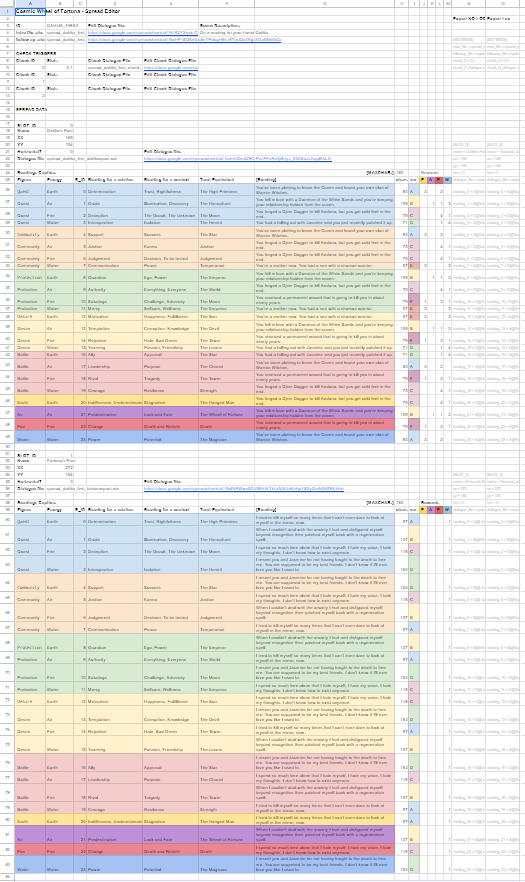
Images via Devolver Digital
de Paco: Depending on what elements you used in the card you're placing on each slot, it allows you to access a series of interpretations assigned for that scene. Of course, there aren't 24 possible outcomes for every single question of the game (typically there are between 4 to 8), but there are 24 different paths (card meanings) to access each of them.
We didn't obsess over creating the whole map of narrative branching from the get-go. Instead, we developed the story chronologically, knowing where we wanted to direct the story towards, and... did actual divination on the character's requests. Then we'd pick the ones that didn't blew the scope of the game out of proportion, and saved them in a directory of possible futures (that has about 500 possibilities in it for the whole game), and whenever we had to develop a new chapter, we checked which of this possible futures could play a role here.
By the end of the development it was more a matter of tying all the loose ends we left hanging throughout the development of the story. It was quite risky, really, but we felt that this process helped making the divination feel more authentic, and the character's evolution more in synch with what you read for them in the cards.
The Cosmic Wheel Sisterhood takes players to a compelling new world in Fortuna's asteroid home. What thoughts went into designing this magical, otherworldly place?
González: Fortuna’s little house is a central piece in the game since it’s something that's almost always on the screen and it’s essential for the mood of the game. Initially it was going to be a single room, but soon we had the idea of a two-story house to separate different spaces. Upstairs for receiving guests, and downstairs a more intimate room with Fortuna’s bed and an altar to craft her cards. I included many decorations to make you think about her life and what she has been doing at home for 200 years. One of the most important things in designing the house (and the whole game really) is the colors, and from the beginning I was sure that I wanted this purple palette, but the specific tones changed a lot during development until the final result.
The game is also filled with compelling characters. What thoughts went into making so many different, striking witches and people for Fortuna to meet? What thoughts went into creating their visual designs and fashion styles?
de Paco: Every witch tries to embody a different aspect, role, or prominent characteristic, that a member of a community can have, since community was one of the main themes of this game. We started out deciding what topics we wanted to explore, and what kind of characters would be better vehicles to talk about them. Then we'd decide on what kind of powers and specialties these witches would have that reinforced the ideas they were meant to embody.
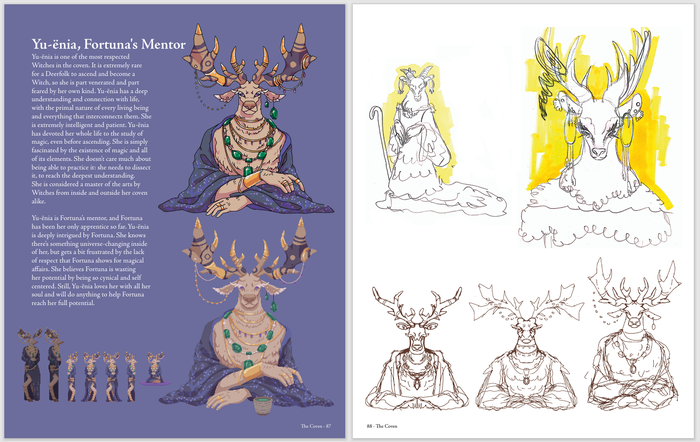
Images via Devolver Digital
González: For the visual part, Ivan Papiol was again a key element in this process. Jordi would write a very short bio for every witch, define the concepts they were meant to represent, and a moodboard of 4 or 5 images. Then I'd get Ivan's concept art and work on the pixel art implementation and all of their animations to make them feel alive while you were talking to them.
Regarding fashion, we tried to capture currents from many different cultures on earth since most Witches in the game ascended from different moments and locations in human history. But also, some of them had to feel otherworldly, so we referred to nature and space for inspiration.
Likewise, what ideas went into the music for the game to strengthen the game’s otherworldly visuals and deeply-familiar human connections?
Ruiz: We had very clear from the beginning that each character needed its own track, and each track should be able to work with all the possible emotions the characters can have while also showing their personality. I would say that's how it worked for the whole project, including the cutscenes tracks... expressing emotion, not being afraid of a wide musical range, but also retaining a core "Cosmic Wheel Sisterhood" sound. It was hard, but I feel that I was able to do it and I'm happy about how it all came together.
What do you hope players take away from the ways in which their fortunetelling can change a digital life?
de Paco: The creative thinking. Widening your tools to reflect about anything. We've used Tarot to come up with ideas during a game jam or to explore our inner muse and find out what we'd love to work on. Much like in the game, divination is not only about looking into the future; it can be a transformation spell.
You May Also Like